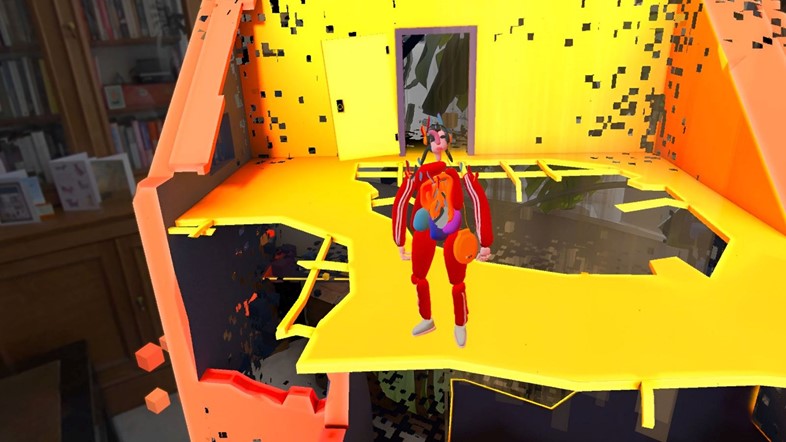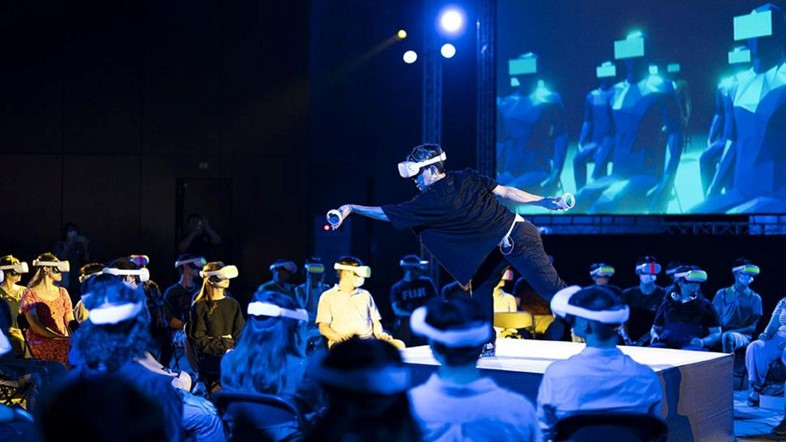This year’s Immersive event at Venice Film Festival made a powerful case for the format’s ability to better understand issues around the body and neurodiversity
Remember the guy filmed driving a Tesla on autopilot while grasping at thin air with his VR headset? That’s how the brave new world of immersive media is often framed in popular culture: another step in the long, slow uncoupling from our bodies engendered by digital technology. But what if new forms of media offered new ways of understanding our bodies? It’s a thread running through this year’s Venice Immersive event, a showcase for all things artificial, augmented and extended which took place as part of Venice film festival this month. “The body and mind is really a key theme this year,” says Liz Rosenthal, a curator and co-founder of the Immersive festival, citing a clutch of projects from this year’s edition. “We have a lot of projects that find ways to empathise with people’s experiences and perceptions of reality, but do it in a way that is poetic and emotional.”
In Ceci Est Mon Coeur, six participants are invited to wear a hand-embroidered cloak that lights up in tandem with an audiovisual installation projected on to a translucent screen. It’s the brainchild of brothers Stéphane Hueber-Blies and Nicolas Blies, who created it as a way to process their own traumatic histories of sexual abuse and childhood illness. “We both have problems with our bodies and we always wanted to be invisible to other people, to hide ourselves [away] and even to destroy our bodies,” says Blies. “That’s why we wanted to create a collective experience, something that held a mirror to the self by showing the beauty of everyone.” The brothers are documentary-makers whose last feature, Zero Impunity, screened at Annecy film festival in 2019. “It was about sexual abuse in warzones and it was a very engaged movie, very political,” says Blies. “It was hard, because for three years we were hearing testimony from people who were often putting themselves in danger [by speaking]; they were super courageous. It made us think, ‘If these people are able to open up, maybe we should do it.’” Dreamlike and uplifting, the project will resonate with anyone who’s had a hard time accepting their body.
Across this year’s event, there are projects tapping immersive’s potential to foster a deeper understanding of the body and mind through other people’s experiences. In Impulse: Playing With Reality, an interactive, mixed-reality experience narrated by Tilda Swinton, participants are offered a unique window into life with ADHD via bizarre-but-intuitive gameplay and narration from an inspired cast of people living with the condition. It’s a seamless, wittily visualised experience that doesn’t so much explain how ADHD works as it does put you right there; no surprise it wound up taking the Achievement prize home at the end of the festival. Turbulence: Jamais Vu is offers disorienting insight into another, lesser-known condition: its director, Ben Joseph Andrews, has lived for most of his adult life with vestibular migraine. Sitting viewers at a desk with objects mapped on to a VR headset, we’re asked to complete simple tasks while the visuals mimic a bizarre range of symptoms in which reality seems to melt away before our eyes.

If immersive media naturally lends itself to such projects, another area it tends to excel in is documentaries. Projects such as Arif Khan’s Address Unknown: Fukushima Now and All I Know About Teacher Li find engaging ways to tell stories of global import: the former, a VR experience taking us into the heart of the Japanese town devastated by a nuclear accident in 2011, the latter, an interactive mixed-reality doc telling the story of ‘Teacher Li’, a Chinese art student living in Italy whose Twitter account became a lightning rod for protest against the draconian excesses of the Covid-era Chinese state. ‘Zhuzmo’, the anonymous creator behind the project, says a video recording of the experience brought tears to the eyes of Li, whom they have never met personally. “It’s a bit like a spy movie – we deliberately avoided sharing our schedules and plans during the festival,” they say of Li, who is now unable to return to China, where his parents are harassed regularly by police. “I don’t even know if he made it to Venice, but I like to imagine a scenario where he secretly booked a VR screening and experienced the piece firsthand.”
Katayoun Dibamehr, a producer with French XR and film production company Floréal, has been coming to the festival for six years. “All the big players are here,” she says, noting that Venice is unusual in the film festival calendar in offering a marketplace to immersive projects still in development. “Apple, Meta … you want to make sure you are here because it’s very rare for them to go anywhere.” One of the projects she’s shepherding to completion this year is A Cure for Straightness, an intense and moving haptic piece from Cameron Kostopoulos on the horrors of conversion therapy, while one project Floréal have in competition, Impulse, is part of an ongoing series part-financed by Meta: there’s a follow-up in development, about body dysmorphia, which they’ll have to pitch separately to win funding.

“I think we’re at a moment [in the industry] there will be a little bit of a reflection around what kind of projects are working and which model they want to continue investing in,” says Dibamehr. “It makes sense, because even as producers we are asking the same questions. VR is a very tricky medium. If you don’t have a distributor, if you don’t publish on a store or have a gallery where you can show your work, people are just starting to think, is it really worth it to just go to festivals, for the amount of work you put in? So this is still quite an issue in the industry, I think.” She sees gaming as an important area of development, as there is “an existing business model” creators can seek to benefit from.
Whatever its future, a reminder of the unique joys immersive media can bring comes with Tung-yen Chou’s Free Ur Head, an ingenious VR piece placed craftily on the Lido right opposite the red carpet. In it, 32 participants are asked to sit in rows before donning headsets in which their only instruction is to follow a light-ball with their heads. “What people don’t know is that it’s all synchronised,” says Immersive co-founder Michel Reilhac of the project, set to a pulsing techno score and led from the front by an energetic conductor. “It’s only at the end when they can see a video of their performance that they realise the whole thing is a setup where the spectators become performers, providing a show for passersby who have no idea what’s going on. It’s the element of surprise that makes it.”
